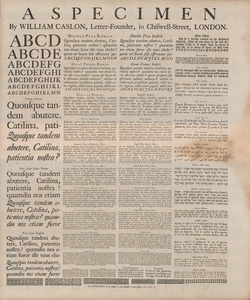| Method | Letterpress |
| Artist | William Caslon |
| Published | [William Caslon, London, c.1750] |
| Dimensions | Sheet 495 x 415 mm |
| Notes |
A large broadside specimen sheet of various typefaces from the foundry of the celebrated type-founder William Caslon, issued for inclusion in the entry for 'Printing' in Chambers' Cyclopaedia, the various editions of which did much for promoting Caslon's work to a wide audience. The sheet is divided into four columns of sample text, with the names of each typeface listed above each sample. Standard 'roman' typefaces use extracts from Cicero's first Catilinarian oration as their sample text, with the uppercase alphabet below. Of most interest typographically though are the samples of so-called 'exotics' found in the fourth column, which include stylised typefaces for Old English, Blackletter, Gothic, Coptic, Armenian, Syriac, Samaritan Aramaic, Arabic, Hebrew, and Greek. Appropriately, the sample type for each is a different text, so the Blackletter faces provide a sample of legal text, and the Greek draws from Xenophon's Memorabilia quoting Prodicus. The specimens of French Canon in the first column do not seem to have been Caslon originals, and are likely adaptations of Moxon's typefaces. Below the type, various decorative border blocks are also included, above an instruction to the binder: 'This Specimen to be placed in the Middle of the Sheet 5 U u, Vol. II.' William Caslon (1692-1766) was an English typefounder, regarded in his own time and in the present day as the most significant English typographic designer. Originally a gunsmith and instrument maker, Caslon's work producing book binding tools put him in contact with some of the leading printers of his era, including William Bowyer, who encouraged him to start his own type foundry. Although his initial founts were mostly 'exotics,' designed to capitalise upon gaps in the market for English printings of foreign typefaces, he is best known now for his roman typefaces based on Dutch baroque examples, many of which are still in use today. Caslon typefaces were used extensively throughout the British empire, including for the original printing of the American Declaration of Independence, and experienced a revival in the Arts and Crafts period, through use by private presses like the Chiswick Press. Condition: Central horizontal fold, as issued. Dirt staining to right of central fold. Minor time toning to edges of sheet. |
| Framing | unmounted |
| Price | £400.00 |
| Stock ID | 52971 |

